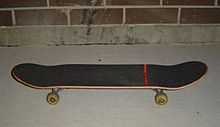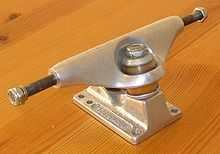List of skateboarding terms

This is a skateboarding related list that defines anatomy, maneuver, venue, and physics terms that are important to skateboarding.
Anatomy of a skateboard
A skateboard is made up of many parts both movable and immovable that when put together allow a rider to propel him or herself forward and steer left or right. A skateboard is propelled by pushing with one foot while the other remains on the board, or by pumping in structures such as a pool or half-pipe. A skateboard can also be used by simply standing on the deck while on a downward slope and allowing gravity to propel the board and rider.
Board parts
- Board: Also known as the Deck, this is the main part of a skateboard, the portion that is used to skate on. Boards are typically made of 7 or 9 plies of maple, birch, or some other wood, laminated together and shaped into numerous board shapes.
- Grip Tape: sandpaper affixed to the top of the board with adhesive. Grip tape provides traction so movement from the feet is transferred to the board.
- Nose: the front of the skateboard.
- Tail: the rear of the skateboard, usually measured from the rear truck bolts to the end of the board. (usually curved up at about a 10 degree angle from the rest of the deck)
Truck parts


- Trucks: The truck is the collective name for the front and rear axle assemblies that connect the wheels to the deck and provide the turning capabilities for the board. The major components of the truck includes the base plate, axle, and the hanger. Also to sustain the weight bearing of the load on top.
- Axle: The axle is a metal rod which runs through the hanger and extends from it on either side. Wheels are inserted on either end and secured with the axle nut.
- Wheels: usually made of polyurethane and sized between 39 and 70 millimeters in diameter; their hardness is measured by durometer, a number ranging from 0 to 100—soft wheels have a durometer of about 85, hard wheels have a durometer of 98 or higher .63 mm wheels are usually more for longboards which go significantly faster.
- Wheelbase: the distance between the front and back wheels, measured between the two sets of innermost truck holes. a wider wheelbase essentially adds stability as the board gains a wider center of gravity.
- Kingpin: Is a partially threaded pin placed through the base plate and truck and secured with the kingpin nut. The Kingpin holds the bushings, truck hanger, and base plate together.[1]
- Bushing: Bushings are donut-shaped polyurethane pieces that are inserted onto the kingpin of a truck. There are two bushings per truck, one above and one below where the hanger fits onto the kingpin. Adjusting the kingpin nut to tighten or loosen the bushings will adjust the turning radius and response of the truck itself. Tighter bushings mean stiffer trucks and less chance of wheel bite, while loose bushings make for easier turning but a greater chance of wheel bite.[1]
- Pivot Cup: A raised and hollowed receptacle on the base plate opposite the kingpin which holds the pivot bushing.
- Pivot Bushing: A plastic cup-shaped piece which rests in the pivot cup of the base plate and supports the truck's hanger at the pivot point allowing the truck to pivot smoothly. The pivot bushing prevents frictional conact between the truck and the base plate and provides a cushioned pivot point.
Bearings
- Bearings: In skateboarding bearings allow for the smooth turning of a wheel on its axle. Bearings consist of 2
balls enclosed in races between two shields encased in a disc-like body. Bearings can be measured by an ABEC rating.[2][3] Skateboard bearings typically come in sets of eight and are inserted into both sides of the wheel; two bearings for each of the four wheels.
- Crown: Crowns are also called retainers or cages and are usually made of Delrin. Crowns hold and separate the individual balls in a bearing.
- Bearing Shield: Are the two walls that hold the ball bearings and Delrin crowns from falling out. The bearing shield plays an important role as well in keeping dirt from getting into the bearing and slowing it down. Some bearings have only one shield and can be taken apart for maintenance.
- C Clip: The C clip is a mechanism for locking bearing shields in place. It is essentially a thin C-shaped wire that fits tightly into a groove around the outside perimeter of the bearing shield to hold it in place against the bearing casing. Not all bearings have a C clip, but those that do can usually be taken apart for cleaning and maintenance.[4]
- Casing: The casing is the body of the bearing. It holds the ball bearings, crown, and shield in place.
Skateboarding trick terminology
- Air: riding with all four wheels in the air.
- Backside: a trick executed with the skater's back to the ramp or obstacle, or a rotation of the rider/board where the front foot moves forward (e.g. a regular-footed skater turning clockwise).
- Caballerial: a 360-degree ollie while riding fakie. The Caballerial was named after Steve Caballero, who invented the trick on vert in the early 1980s.
- Carve: to skate in a long, curving arc.
- Fakie: rolling backwards; the rider is in the normal stance, but rolling in the opposite direction.(Basically a switch nollie position)
- Frontside: a trick executed with the skater facing the ramp or obstacle, or a rotation of the rider/board where the front foot moves backward (e.g. a regular-footed skater turning counterclockwise).
- FS 540: a frontside 540-degree turn.
- Goofy-Foot: a skater who more comfortably rides with the right foot leading.
- Grind: scraping one or both truck axles on a curb, railing, or other surface.
- Crooked Grind: a nosegrind where the nose is angled toward the object and the tail is elevated.
- 50-50 Grind: a grind on both trucks.
- Nosegrind: a front truck grind with the rear of the board elevated over the obstacle.
- 5-0 Grind: a rear truck grind with the front of the board elevated over the obstacle.
- Smith Grind: a rear truck grind, with the nose pointed below and slightly away from the obstacle.
- Two Grinds: A grind on one truck, followed by a grind on one truck.
- Kickflip: an ollie in the middle of which the skater uses the front toe to kick the board into an Aileron roll.
- Heelflip: a kickflip in which the skater uses the front heel to flip the board in the opposite direction.
- McTwist: a backside 540-degree turn usually performed on a ramp (generally a mute grab).
- Mongo-Foot: pushing with the trailing foot kept on the board; most commonly used to push fakie.
- Nollie: An Ollie performed with the front foot (N/ollie nose ollie) Can be referred as a fake or switch ollie, or it could be added as a prefix to describe any other trick performed in fake or switch stance (Nollie 360 Flip, Nollie Kickflip, Nollie Lazer, etc.).
- No-Comply 180 : A one-footed 180 where the front foot plants on the ground and the back foot pops the board 180 degrees and then the plant foot is brought back onto the board
- Noseslide: sliding the underside of the nose end of a board on a ledge, rail, or lip.
- Ollie: a jump performed by popping the tail of the board on the ground, and using the front foot to even out your body and attain air. The basis of most skating tricks, named after Alan "Ollie" Gelfand. See: Air, Pop
- Pop: the act of striking the tail of the board against the ground to propel the board upwards.
- Boardslide: a trick in which the skater slides the underside of the deck along an object.
- Regular Foot: a skater who more comfortably rides with the left foot leading.
- Shove-it: a trick performed by spinning the board 180 degrees beneath the feet without the skater spinning.
- Switch Stance: riding the board with the opposite footing than usual.
- Tailslide: sliding the underside of the tail end of a board on a ledge or lip.
- Pop Shove-it: A shove-it performed while popping the tail to make the board attain air. See: Air, Pop
- Top Gun: A trick performed in the air, by grabbing the side of your skateboard with your back hand and suspending your feet from the deck.
- Varial Kick Flip: A trick consisting of a backside pop shove-it and a kickflip.
- Varial Heel Flip:Same as a hard flip, but you heel flip and the board spins front side.
- 360 Flip: A 360 shove it and a kick flip. The board does 1 full rotation.
- Ollie North: an Ollie in which the front foot is taken off the board.
- Laser Flip: A frontside 360 shove it and a heel flip. The board does 1 full rotation.
- Hard Flip: Instead of the board spinning backside, the trick is performed by doing a kick flip and having the board spin frontside.
- Inward Heel Flip: A heelflip variation where the board simultaneously rotates 180 degrees backside
Casper flip: when doing a kickflip, you catch it as the board does a quarter of the rotation and bring it around like a shuv-it with your front foot.
Skateboarding Venues
- Street skateboarding: skating on streets, curbs, benches, handrails and other elements of urban and suburban landscapes. Also ramps, rails, boxes and other man-made obstacles especially in competition are now referred to as street because they simply emulate a perfect "street" environment, plus the man-made street ramps are mobile, making easy transport for competitions, local skaters and retailers alike.
- Bust: A street skateboarding spot where you are likely to be kicked out by security or police.
- Vert skateboarding: skating on ramps and other vertical structures like empty bowl-shaped swimming pools and occasionally storm drains and such.
- Half-pipe: a U-shaped ramp of any size, usually with a flat section between the opposing transitions.
- Vert ramp: a transition ramp, usually at least 8 feet tall, with steep sides that are perfectly vertical near the top.
- Mini ramp: usually a half pipe that is shorter than the rider; most mini ramps are not tall enough for the transition to reach vertical.
- Mega Ramp: a very big ramp, Usually for vert.
- Quarter pipe: a single ramp transitioning from horizontal to any obtuse angle up to vert.
- Bowl: Empty in-ground pools serve as good bowls. Concrete and wood bowls have been made for skating. As with a half pipe, a bowl is better with a flat bottom between the transitions.
Physics as applied to skateboarding
- Centripetal Force: a force that keeps a body moving in a circular path.
- Rotational Inertia: a measure of an object’s resistance to being turned, depending on both the mass of the object and how that mass is distributed.
- Work: force applied over a distance—for example, you do work when you push a box across the floor, but not when you push on a locked door; work done on an object or system results in an increase in the energy of that system.
Friction is the resistance that one surface or object encounters when moving on another.
See also
References
- ↑ 1.0 1.1 "Anatomy". Skatewarehouse.com. Retrieved 2009-04-20.
- ↑ "ABEC ratings and what they actually mean". Lushlongboards.com. Retrieved 2009-04-22.
- ↑ "Skate Bearings - Frequently Asked Questions". Miniature Bearings Australia Pty. Ltd. Retrieved 2009-04-22.
- ↑ "Anatomy". Skatewarehouse.com. Retrieved 2009-04-22.
| ||||||||||||||||||